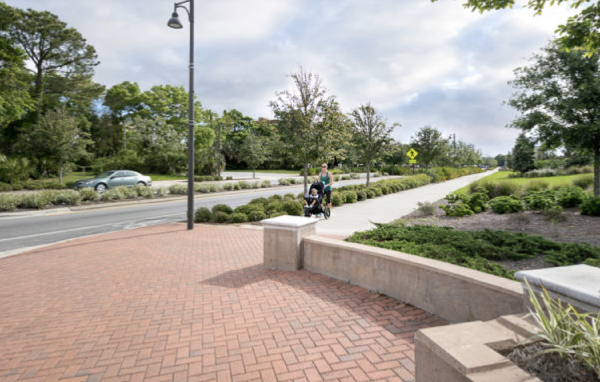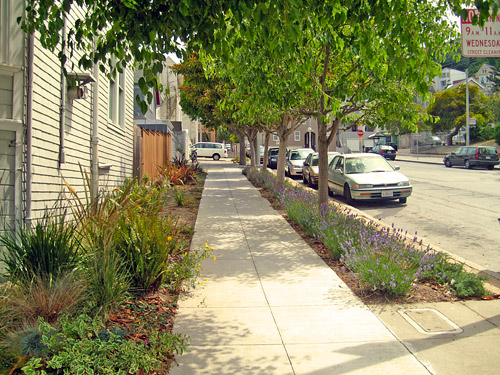Golfweek Features Jerry Pate Design and Teeth of the Dog - Read More
Golfweek Features Jerry Pate Design and Teeth of the Dog - Read More

Landscape Architecture for Stunning Sidewalks
Sidewalks can be an opportunity to incorporate smart, people-friendly landscape design. Here’s what you might consider:
Sidewalks are often a somewhat neglected part of public areas in our towns and cities.
For areas that usually attract a lot of human traffic, there’s often much more that can be done to make them attractive, safe spaces. Considering landscape architecture for sidewalks helps to improve the area, potentially encouraging more people to walk it.
In many cities, property owners are “adopting” sidewalk areas and making improvements. City schemes are popping up all over the country to allow this and we’re seeing some amazing spaces created.
Could the sidewalks in your area use improvement? Here’s why it’s worth considering landscaping:
Free download: Examples of stunning sidewalks
Benefits of landscaped sidewalks
First of all, there are the practical, safety benefits of looking after (or installing) sidewalks. You can create a safe zone between pedestrians and traffic for one thing. Secondly, you can tidy up hazards that may be along the way on current sidewalks. Things like broken concrete, narrow areas and overhanging branches.
Common problems with sidewalks include narrow width, which often contributes to them feeling unsafe to the people walking them. The condition of the sidewalk may also make it unattractive – if it is crumbling, cracked or strewn with litter, these will also serve to drive people away. Drainage can also be an issue – you won’t see people using the sidewalk if it is frequently flooded. In some areas, this might also create a hazard with ice. Making changes to how you approach stormwater drainage can also help to improve water quality in the area and reduce pollution.
The underlying benefit of landscaping and looking after sidewalks is that you create a better space for the people who inhabit the area. You can create an interesting sidewalk that they want to get out and use, which can lead to other benefits such as:
- Improved property values in neighborhoods.
- More pedestrian traffic for local businesses.
- Getting people out of their cars sooner. This can help to ease any congestion issues, as well as reduce air pollution.
- Creating habitats for wildlife and insects.
- Creating a healthy space that encourages exercise and for people to meet.
- Creating spaces with more than one purpose, for example, some areas have put edible gardens in to share with communities.
- Encouraging more parents to allow their kids to walk or bike to school. In many areas, there is not enough space for safe separation from traffic, so parental perception is that it is unsafe.
We believe in creating spaces that people love to use. Sidewalks don’t have to be a strip of uninteresting pavement, they can really be an appealing pathway to places of interest. Next, let’s look at some ideas for what you can do to spruce up sidewalks.
Landscaping for sidewalks
Sidewalks may offer you a lot of space or a little, but there’s plenty you can do to create a stunning space. Some key things to consider before making landscaping decisions are:
- Who primarily uses the space and where are they going? For example, if it is en route to schools, you’d want to think about how much space you provide so that groups of children can walk safely.
- Are there any known issues with stormwater? How much rain does the area get and how close is it to waterways?
- What is the weather like? Do you need shade for summer or shelter for stormy days?
- Is the space to be shared by people on bicycles or scooters? If so, consider how much space is required so they are safely separated from pedestrians.
- Do you have an easement (the grass strip between sidewalk and road, which may otherwise be known as a right-of-way, pedestrian zone or hellstrip)?
- Does any of the space belong to local businesses? For example, restaurants or cafés may have space for tables.
- Does public transport stop along the space? You would need to consider incorporating bus shelters and safe areas around them.
- What permits (if any) are required to do landscape work to sidewalks?
Here are some ideas:
Widen sidewalks and set back from the street
One of the first concerns of any sidewalk project should be safety. Wider sidewalks (if possible) that are set back from the street help to create a good separation between pedestrians and vehicles. It’s safer for pedestrians, and more comfortable too. No one enjoys being splashed or buffeted by cars!
Here’s an example of a project we did in downtown Pensacola. This area could once be described as a blighted downtown, but some landscaping strategies have rejuvenated the space and created an area where people love to walk.
One of our strategies was to widen sidewalks and set them back from the street. We also created corner plazas to allow more space for people to gather and for safer entrances into Community Maritime Park. Note too that smooth pavers, maintained to be in good condition, create a safe and attractive surface for pedestrians.

Plantings in easements and next to sidewalks
You can see from our picture above that we had a fairly wide space to work with and could create wide sidewalks along with a significant amount of easement planting between the sidewalk and the road. In some places, you won’t have as much space to work with, but you can still plant an attractive easement, or plant in the space on the other side of the sidewalk.
What and how to plant will very much depend upon your area and the conditions you are dealing with. For example, your easement may be a great place for bioretention cells – conditioned soils and plantings that help to filter stormwater.
Some other factors to think about include:
- Avoiding plants such as invasive ground covers that may provide coverage for pests.
- Avoiding plants with thorns or spikes.
- Being aware of where any plants may be close to people going by. For example, you wouldn’t want to plant delicate flowers right next to where someone may step out of their parked car.
- Any native plants that will suit the space. Natives are great because they’ve been developed to withstand your local weather conditions. They also provide wildlife habitat and are often low maintenance once established.
- Avoiding any tall, dense hedges or trees. Limiting visibility can create safety issues.
- Consider proximity to a water source (or having one put in) if the plants will need watering.
Below is an example of sidewalk planting on both sides, taken in San Francisco and sourced from SF Better Streets. Note that the trees planted allow plenty of visibility while still providing shade, and all other plants are relatively close to the ground.

Creating areas to sit or gather
You can encourage more diverse groups of people to walk and use the space if you are also able to create areas where they can relax. Street seating can also help to benefit local businesses by providing people with a place to gather, or perhaps to sit down and eat.
When you think about seating areas, you should also consider factors like shade or shelter from the elements. Perhaps in your town, sitting for a spell on a seat in the shade would make a nice break from shopping, encouraging people to visit more businesses once they’ve had a rest.
In Portland, Oregon, they have a program called Street Seats which allows businesses and nonprofits to convert on-street parking into other public uses, such as seating or “mini parks.” There are similar programs in other cities around the country. The picture below is one example from the Portland program. Note that there is also plenty of space for bicycle parking!
Free download: Examples of stunning sidewalks

Final thoughts
Our main message is that sidewalks don’t have to be boring. You can make them attractive areas that encourage connecting in your community.
A good sidewalk is very safe and walkable. People feel comfortable that they are separated from traffic and that the sidewalk itself doesn’t present a hazard. It is functional for people who need to get from A to B, and at its very best, it actually encourages more pedestrians.
Sidewalk landscaping can revamp blighted areas and benefit businesses by bringing more foot traffic. Your sidewalks can become a valued part of your community.